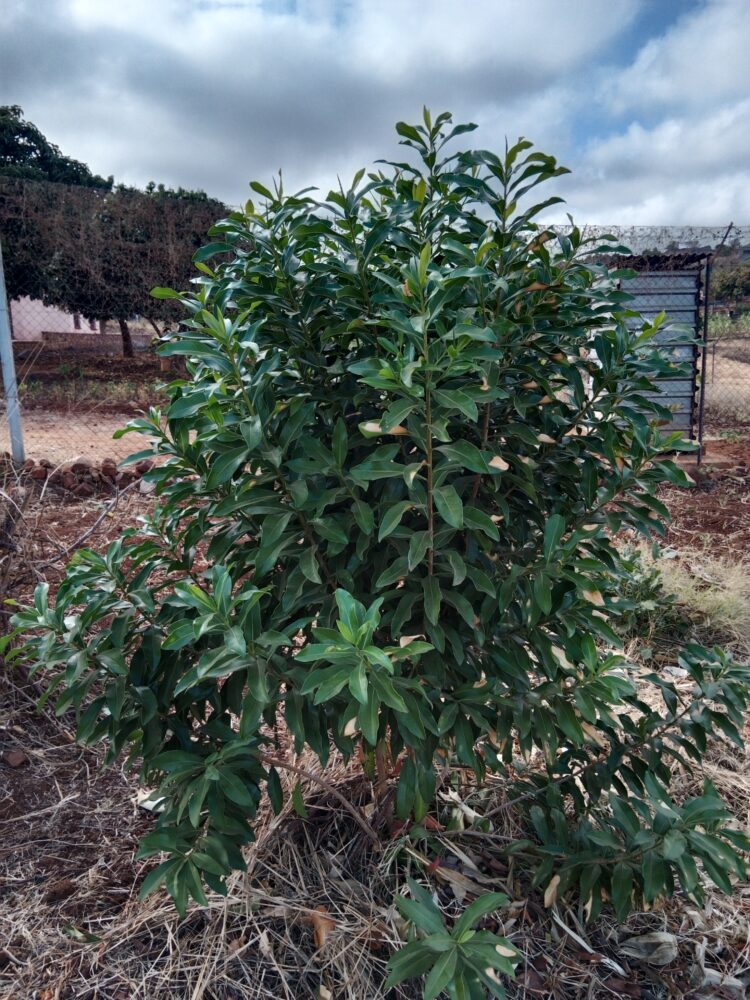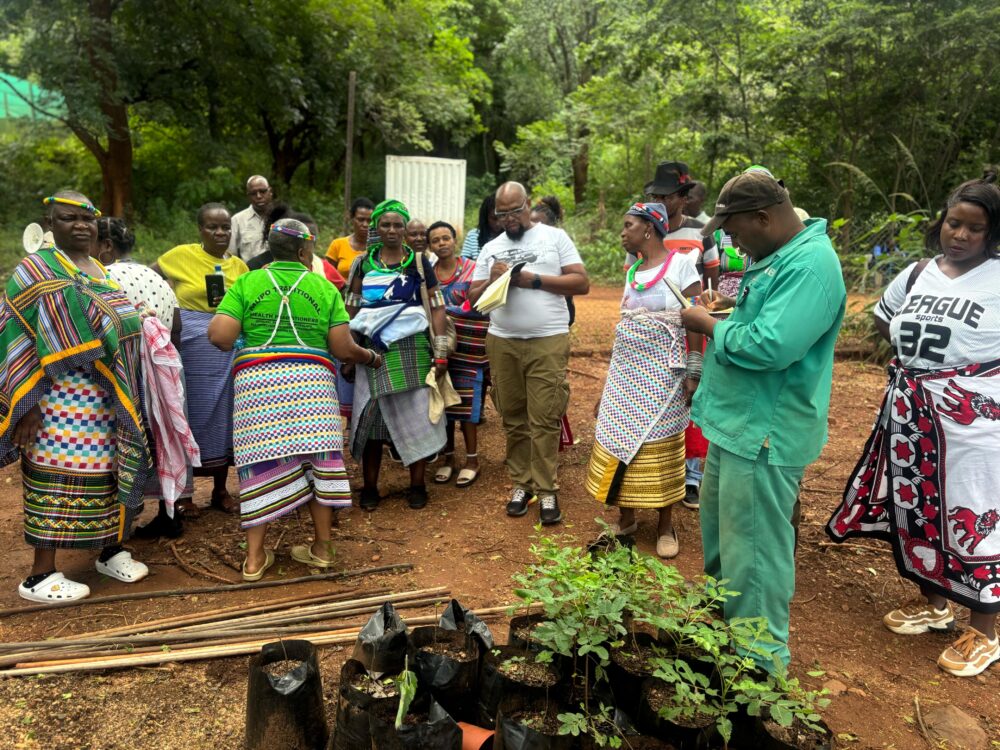The pepper-bark tree project incorporates collaboration with traditional healers, traders and harvesters (EWT Pepper-bark Project)
For thousands of years, Africa’s landscapes have yielded plants with healing powers, sustaining not only traditional medicine but also cultural identity and livelihoods.
In South Africa, these deep-rooted and ancient traditions are now under threat — yet are also finding new life through collaboration, conservation and community leadership.
Historically, cultural rituals, protocols and practices and a profound cultural reverence for nature helped manage plant harvesting sustainably, explains Jenny Botha, the programme manager for People in Conservation at the Endangered Wildlife Trust (EWT).
But as human populations have grown and rural populations migrated to urban areas, demand has increasingly outstripped the available sources of many plant species. This, together with the erosion of harvesting controls and extensive habitat transformation through other human activities, has placed considerable pressure on numerous medicinal plant species.
South Africa alone uses more than 2 000 plant species for traditional medicine, with 770 species recorded in local markets. Of these, 182 appear on the IUCN Red List of Threatened Species and at least 82 are believed to be at risk of extinction in the wild.
One of the most iconic medicinal plant species among them is the pepper-bark tree (Warburgia salutaris), long revered in Southern Africa for its healing properties. It is used for everything from respiratory ailments to digestive issues.
Under the SAPPI Rare and Threatened Species Programme, started in conjunction with SANParks, the EWT received 1 600 pepper-bark tree saplings from its projects in Limpopo in 2019. These saplings were provided by SANParks’ nursery at Skukuza in the Kruger National Park.
Native to montane forests, thickets and woodlands in these regions, the pepper-bark tree has also been found in Mozambique and eSwatini but is believed to be extinct in the wild in Zimbabwe.
SAPPI works with SANParks, the Mpumalanga Parks and Tourism Agency (MPTA) and Ezemvelo-KZN Wildlife as these government institutions not only work in the conservation sphere, but also with communities and traditional healers.
“The traditional healers, with their knowledge and willingness to look at more sustainable options, underpins the work that the EWT is doing,” says Botha.
The pepper-bark tree’s bark, roots and rootbark have historically been in high demand for traditional medicine across Southern Africa. Encouragingly, more recently, many of its therapeutic properties have been corroborated scientifically.
“From a conservation perspective, its leaves were found to contain the same phytochemicals as the other plant parts that were traditionally used for medicine,” Botha says, noting that the substitution of leaves for bark, roots or rootbark significantly reduces harvesting impact.
“We’re starting to see healers and others, also in the local markets, also start using the leaves because people are finding that they are as effective in medicinal treatments as the bark and the root in many cases … One species will be used for very diverse, different uses in many cases and the pepper-bark isn’t an exception.”
Over the past three decades, national and regional conservationists have partnered with traditional healers and private sector players to mitigate over-harvesting through cultivation.
The EWT’s Pepper-bark Tree Project incorporates collaboration with traditional healers, traders and harvesters to increase the diversity of species that are being cultivated in many areas.
“In addition, we are implementing strategies alongside private and communal landowners to protect and restore habitats. A seed viability assessment has also been conducted as the species germination rates in some populations are low,” Botha says.
 Native to montane forests, thickets and woodlands in these regions, the pepper-bark tree has also been found in Mozambique and eSwatini but is believed to be extinct in the wild in Zimbabwe.
Native to montane forests, thickets and woodlands in these regions, the pepper-bark tree has also been found in Mozambique and eSwatini but is believed to be extinct in the wild in Zimbabwe.
To secure habitat for the pepper-bark tree and other species, the EWT has collaborated with the Limpopo department of development and tourism and private landowners to secure formal protection of land through South Africa’s Biodiversity Stewardship Programme.
More than 70 hectares of invasive vegetation has been cleared from pepper-bark tree habitats in Limpopo, an effort that has triggered the reappearance of tree seedlings in areas where they had long been absent.
“We are also engaging with several communities in areas where pepper-bark trees and other medicinal species are being intensively harvested to explore opportunities to support them to improve harvesting controls and remind people of the importance of their biocultural heritage.”
Harvesters frequently come from outside the area “and, where possible, we invite them to join this national effort” to improve the sustainability of medicinal plants for now and for future generations.
The EWT has engaged with about 300 traditional healers from more than 20 communities in Limpopo to identify strategies to reduce threats to wild medicinal plant populations.
Training and education are vital pillars of the programme. In February and March, the programme collaborated with the South African National Biodiversity Institute (Sanbi) to develop and implement training on the cultivation of medicinal plants.
“This training will gradually be implemented across all our project areas to support cultivation and lay the foundation for scaling up these production efforts over time.”
Following visits to Sanbi’s Thohoyandou Botanic Gardens, over 20 traditional healers and harvesters attended hands-on training courses in Limpopo’s Vhembe district.
The training incorporated demonstrations of various cultivation and propagation techniques, discussions on legislation and the permitting system and engagement on challenges people are facing in accessing medicinal plants.
Each participant received seedlings and a starter pack to begin growing medicinal plants immediately. “We work with organs of state i.e. SANParks, MPTA and Ezemvelo KZN Wildlife as they are mandated by the government to work in this arena with communities and traditional healers.
“Our team follows up with the groups regularly to monitor the survival of plants and any challenges that they may be experiencing. We are also in the process of sourcing additional species for them to start growing,” Botha says.
She notes how, in many rural communities, traditional harvesting was once guided by strict controls to ensure wild plant populations thrived. While some of these have faded under modern pressures, the knowledge and values remain.
“There’s also an open commons challenge. You’ll find that people will go to a site that is open access and then they know that, if they don’t harvest those plants, then somebody else is going to come in and do it.”
Traditional healers themselves still try to follow very strict harvesting protocols and “there are a lot of cultural protocols associated with harvesting that are very, very important”.
“There are some types of plants that need to be collected from the wild but a lot of the healers whom I knew were growing plants before we started, whether it was in this project or projects I’ve worked on in Mpumalanga or other areas.”
Many medicinal plant species are slow-growing or “sometimes the seed may be recalcitrant” and it can be difficult to actually propagate them.

“The work that we’re doing is helping the healers and other stakeholders to strengthen their cultivation skills and then also to provide the diversity of species that they actually need.”
This is because most healers use a very diverse suite of species, Botha says. “It’s really important that they’re able to access them legally without having to worry about being arrested if someone is caught with a bag of plants.”
Hope lies in collaboration and the pepper-bark project is proof that the species is not only being conserved, but also reinforcing community agency, cultural heritage and sustainable livelihoods.
Crucially, this conservation initiative is not about imposing modern conservation ideas — it’s about reawakening ancient knowledge and co-creating solutions.
“Traditional healers are as passionate about sustainability as we are and in fact, I found that most community groups are,” Botha says.
“It’s a myth that people don’t actually care about the environment because they come from a different background, whether it’s socio-economic or cultural. The healers are as enthusiastic about the work we do as we are.”
This deep ancestral and spiritual connection with nature runs through most traditional healers’ views of the environment.
“People, generally, in our modern society are losing our connections to nature because of technological advancements etcetera. More of us are more fixated on our phones or the latest gadget than we are concerned about walking in nature and experiencing nature in the way that perhaps was more easily accessible to people in the past.”
One part of the project’s mission is to help people reconnect with nature, whether through visiting a botanical garden or walking in a local nature reserve.
“That deep spiritual connection that people have with the land, in this case particularly the healers … it’s a case of reconnecting with nature and rekindling those relationships so that we in that way are able to foster more care for the planet.”
It’s incredibly inspiring work, she says. “I don’t think there’s been a day where I haven’t learned something new or a day where I haven’t met amazing people or reconnected with amazing people from all walks of life.”
Plants have been valued for their curative powers for millennia, not only as traditional medicines, but also in conventional medicine.
“Achieving our goals to reduce threats to species of conservation concern at scale will clearly take time and collaborative efforts across partner organisations and sectors to enable us to synergise our resources and share the knowledge, understanding and collective effort that is required to avert extinctions.”
Critically, the needs of the poorest consumers, who depend on these plants for their healthcare, must be at the forefront.
“Many simply cannot afford more expensive alternatives and it is vital that we co-develop strategies to cultivate plants that are both affordable and aligned to the cultural protocols associated with the use of these medicines, so that their therapeutic values are retained or even, in some instances, restored.”
People from all walks of life, including traditional healers, don’t want to see the loss of their own natural resources. “They value them in most cases for the intrinsic value of the plant as well as the fact that it is part of their livelihoods,” Botha adds.